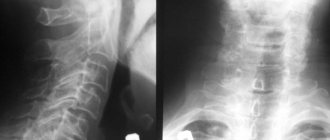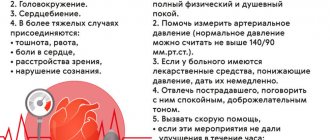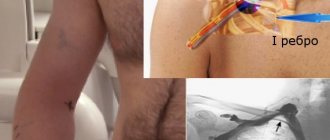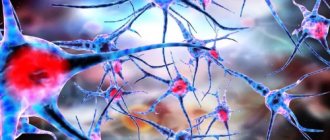Numbness is an abnormal sensation that can occur in any part of the body, but is most often felt in the arms and legs. The symptom of numbness is often accompanied by tingling, and can be quite harmless, for example, in the hands when cooling, to a sign of a serious, life-threatening condition. Numbness is a fairly common symptom. Numbness of the limbs is often accompanied by an emotional context with a feeling of detachment and decreased emotional coloring, which is usually a sign of depression. In a physical context, numbness is usually the result of damage, poor circulation, or pathological changes to certain nerves.
In addition, there may be periodic attacks of numbness and tingling due to the presence of certain health problems, such as neuroses or a migraine attack. Also, episodes of numbness can occur during attacks of fear caused by the anticipation of life-threatening events, and in such cases the numbness is caused by shallow breathing and most often affects the fingers and the mouth area.
Numbness of the hands is manifested by a feeling of loss of sensation in the hands; patients often call this condition “asleep” hands. Numbness may be accompanied by a tingling sensation from the needle. Often such numbness occurs after sleeping with your hands under your head. Numbness in the hands is usually caused by carpal tunnel syndrome, which causes compression of the median nerve. Most often, carpal tunnel syndrome is caused by compression of the nerve in the carpal tunnel. In addition, numbness in the hands can be caused by injuries, hypothermia, or systemic diseases such as diabetes. If numbness of the hands is accompanied by shortness of breath, nausea, and palpitations, then this may be a sign of acute, life-threatening conditions and requires emergency medical attention.
Numbness in the legs is a loss of feeling or sensation in the legs, resulting from disruption of communication between the peripheral nerves and the central nervous system. Typically, numbness in the legs is associated with poor circulation in the lower extremities. This numbness most often occurs when sitting cross-legged for a long period of time. In such cases, getting up and walking can relieve the numbness after a while. But numbness in the legs can also be a sign of serious damage to nerve fibers due to mechanical factors (disc herniation, radiculopathy) or nerve damage due to somatic diseases.
Causes
Numbness can be a sign of a wide range of diseases or conditions that involve restricted blood flow or nerve damage.
Temporary numbness can be caused by any activity that puts prolonged pressure on the nerve(s), such as sitting cross-legged or cycling long distances. Numbness can also occur due to moderate to severe orthopedic or vascular pathology, as well as conditions and diseases that lead to damage to the nervous system. In some cases, numbness is a symptom of a life-threatening condition that requires emergency medical attention.
Cardiovascular causes of numbness
Numbness can be caused by a lack of blood flow to a certain area due to conditions such as:
- Arteriovenous malformations
- Buerger's disease
- Deep vein thrombosis (a blood clot in the legs can break off, which can lead to pulmonary embolism in the lungs, heart attack, stroke)
- Frostbite
- Diseases of peripheral arteries (vascular atherosclerosis, in which narrowing of the arterial bed occurs).
- Raynaud's syndrome, in which persistent spasm of peripheral vessels occurs and blood circulation in the distal extremities is impaired. Vasospasm is usually triggered by cold or sometimes stress.
Orthopedic causes of numbness
Numbness may also occur due to minor or serious orthopedic conditions that cause nerve damage:
- Whiplash neck injury
- Bone fractures
- Carpal tunnel syndrome
- Degenerative diseases of the intervertebral disc
- Herniated disc
- Compression pinched nerve
- Osteoporosis
Neurological causes of numbness
Numbness due to nerve compression or nerve damage may be due to conditions such as:
- Alcoholism
- Brain tumors
- Diabetic neuropathy
- Encephalitis
- Heavy metal poisoning such as lead poisoning
- Hypothyroidism
- Multiple sclerosis
- Peripheral neuropathy
- Spinal cord injury or tumor
- Stroke
- Systemic lupus erythematosus
- Myelitis
- Myelopathy
- Vitamin B12 deficiency
Numbness during pregnancy
Pregnant women face many changes in the body, and numbness is one of them. Some pregnant women develop carpal tunnel syndrome and it is believed to be due to water retention in the body during pregnancy.
As the fetus develops, fluid accumulates in the body, tissues swell, including in the wrist area, compression of the median nerve occurs and carpal tunnel syndrome develops. Symptoms of carpal tunnel syndrome are more pronounced in the morning hours, as fluid accumulates in the body at night. As a rule, carpal tunnel syndrome in pregnant women heals on its own after delivery.
Numbness in children
There are many reasons why children may experience numbness in different parts of the body. Eating disorders, lack of vitamins and minerals can cause numbness in the lower extremities, this is especially typical for a deficiency of B vitamins. Sports injuries can also cause numbness. Therefore, in childhood, parents need to pay attention to children’s complaints of numbness, which lasts more than a few minutes and may be a sign of damage to ligaments, tendons or bone fractures. Often, anxiety in childhood can be a source of numbness in the lips and face.
Cardiac causes of pain radiating to the left arm
Typically, this type of pain appears when there are problems with blood flow. It occurs especially often after physical or emotional stress. Sometimes the symptom worsens and emergency medical attention is required. Therefore, it is important to understand its character in order to prevent the development of complications.
Ischemic disease is a key cause
Cardiac ischemia is a disorder that combines several ailments that differ in the damage to the myocardium. Of these, there are 2 main diseases:
Angina is a disease characterized by discomfort in the chest. Occurs after physical exertion or emotional stress. The pain radiates to the left arm, part of the neck and jaw. The patient's heart aches, and as the pain increases, he experiences a strong fear of impending death.
Important! A distinctive feature of an angina attack is that its duration is about 10 minutes. It is recommended to take a Nitroglycerin tablet or completely calm down and relax, then it will stop on its own.
To prevent this situation, doctors recommend taking medications that strengthen and restore the main muscle.
Myocardial infarction. The disease occurs against the background of obstruction of the lumen of the vessel, which causes a sharp deficiency of nutrients that enter the heart with blood. This spasm causes the death of certain areas of the heart muscle. The person feels a burning sensation, severe pain in the chest, and the left side of the body suffers. Manifestations of the disease are not controlled by vasodilators, and symptoms increase. The patient must be urgently hospitalized for medical care.
Silent myocarditis
One of the causes of chest pain is inflammation of the heart muscle. Pathology stimulates a violation of its excitability, conductivity and contractility. Typical signs are observed 10 days after the onset of the disease.
The patient complains of sensations such as:
- It aches and hurts inside.
- The pain radiates to the left side of the shoulder girdle, pulling.
- Severe weakness, weakness.
- Increased sweating.
- During body movement, unpleasant sensations intensify, making breathing difficult.
- Sometimes body temperature changes.
- Night sleep is disturbed.
- There are interruptions in the heart rhythm.
Important! All manifestations of the disease occur at a time of rest.
The first signal of the onset of changes is asthenia. The patient most often does not pay attention to this and only on the 7th day, when typical signs occur, does he consult a doctor. Unfortunately, during this time the disease enters a severe stage; the patient requires long-term treatment and rehabilitation.
Difficult-diagnosed pericarditis
The causes of inflammation of the pericardial sac are considered to be numerous past infectious, bacterial, fungal, and autoimmune diseases. During this process, fluid collects between the walls of the pericardium, which leads to the development of motor tamponade. The organ loses the ability to effectively contract and relax, so acute heart failure occurs.
Symptoms:
- Breathing becomes difficult.
- The skin becomes pale.
- Dizziness.
- The hand is taken away from the side of the heart.
- Dry cough.
- The lower extremities of the body swell.
- Intense thirst.
- Arrhythmia.
- Possible loss of consciousness.
In case of pericarditis, during auscultation, the doctor will determine a typical noise - pericardial friction.
Unknown cardiomyopathy
This disease has no specific causes. Presumably, the basis for the diagnosis of “cardiomyopathy” is the absence of congenital developmental anomalies, valvular heart defects, changes in blood vessels, and arterial hypertension. Disorders occur in the myocardium, which contribute to the development of cardiac dysfunction. The patient constantly tingles and aches in the chest, the left side of the body is taken away, weakness and sleep disturbance are observed.
Insidious brain stroke
A sudden shortage of blood supply to a certain area of the brain, as a result of which the functionality of the organ changes, is called a stroke.
The circumstances for the development of this condition are considered to be:
- Blockage of a vessel. There is a lack of nutrients and hypoxia of brain tissue. This type of disease is called ischemic.
- Vessel aneurysm. The hemorrhage spreads into the brain and forms hematomas. This is a hemorrhagic stroke; it has a more severe course.
It all depends on which area is affected, and based on this, changes in various body functions are observed.
Common symptoms include:
- Regular dizziness.
- Temporary disturbances of speech, memory and vision.
- Numbness of the upper and lower extremities, decreased strength of movement, up to complete immobilization.
- The patient experiences a feeling of weakness or faints.
- Muscle cramps.
In order to recognize a stroke, you need to ask the patient:
- Smile - asymmetry of the smile will appear.
- Show your tongue - when you try to stick it out, it will bend to the side.
- Ask basic questions - the person makes an unrelated speech.
- Raise your arms - there is uneven lifting of the limbs.
If characteristic signs of a brain stroke are detected, you should immediately call an ambulance. The more time passes, the more severe complications develop. The person is doomed to lifelong disability.
Symptoms
Numbness usually occurs due to poor circulation in a particular area or nerve damage. Sensory disturbances (numbness) can also be the result of infection, inflammation, trauma and other pathological processes. In most cases, numbness is due to non-life-threatening illnesses, but it can also be a sign of a stroke or tumor.
Numbness in the extremities is often associated with pain or may be accompanied by other sensory disturbances such as burning or tingling. Strokes also cause motor and speech disorders. Depending on the cause, numbness may disappear quickly, for example, numbness in the arm , which occurs when a person sleeps with their head on their arm, disappears after a few movements of the arm. Chronic numbness in a leg or arm over a long period of time usually indicates some level of nerve damage, such as due to diabetes or multiple sclerosis. Chronic numbness in the fingers may be due to a pinched nerve, as is the case with carpal tunnel syndrome. In any case, numbness that lasts more than a few minutes merits attention and medical attention. And if a person experiences numbness in the groin area and impaired bladder and bowel function, or there are signs of paralysis, confusion, speech impairment, then in such cases it is necessary to seek emergency medical help.
Symptoms that may accompany numbness:
- Anxiety
- Burning feeling
- Frequent urination
- Increased numbness or tingling while walking
- Itching
- Lower back pain
- Muscle spasms
- Pain in the neck
- Pain in other parts of the body
- Pins and needles sensation
- Rash
- Increased sensitivity to touch
A number of symptoms accompanying numbness may be a sign of serious conditions and this must be taken into account by the doctor, since emergency medical care and necessary medical procedures are often required.
These are the following symptoms:
- Lethargy or momentary loss of consciousness
- Labored breathing
- Difficulty walking
- Dizziness
- Loss of control over voluntary urination or bowel movements
- Visual impairment
- Numbness in the head, neck, back
- Paralysis
- Speech disorders (dysarthria)
- Weakness
Why do my fingers go numb?
Sometimes an unpleasant sensation occurs only in the fingers and does not spread to the hand. Numbness in the fingers of the left
and right
hands
occurs for the reasons described above. But sometimes other conditions can provoke an unpleasant symptom in the fingers:
- pregnancy period (the cause may be a lack of iron and hemoglobin, metabolic disorders, hormonal imbalance, weight gain of a woman);
- damage to peripheral nerves (polyneuropathy) - develops in patients with diabetes. Manifests itself in the form of pain or numbness in the upper extremities. Polyneuropathy also occurs against the background of alcohol dependence;
- Raynaud's syndrome is a vasospastic pathology, characterized by damage to the arteries and arterioles of the extremities;
- Formation of blood clots in blood vessels - if unpleasant symptoms do not go away within an hour, you should consult a doctor;
- Acute polyradiculoneuritis is an acute autoimmune lesion of peripheral nerves. Symptoms are manifested by paresis, decreased sensitivity of the hands, and autonomic disorders.
Diagnosis and treatment
Based on the medical history, study of symptoms and physical examination, the doctor prescribes an examination plan, which includes both instrumental and laboratory examination methods.
To treat numbness, first of all, it is necessary to find out the cause of this symptom. If numbness is associated with circulatory disorders, diabetes or multiple sclerosis, the underlying disease is treated, both with the help of conservative treatment methods and surgical methods (for example, for vascular diseases). For orthopedic problems, such as disc herniation, osteochondrosis, treatment can also be either conservative or surgical (for example, when it is necessary to decompress the nerve root).










